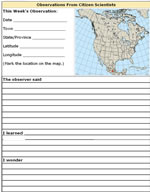How
are Seasonal Changes Affecting Monarchs?
Monarchs can only survive in places where their needs are being met. It's
late September now and many seasonal changes are occurring in the monarch's
habitat. Look for examples in the comments below. In what ways is monarch
habitat changing across eastern North America? Where are the monarch's
needs being met? Where is it becoming difficult for monarchs to survive?
For Your Journal: Each week, choose your favorite monarch sighting and record your thoughts in your journal. >>
Observations from Citizen Scientists
September
19: Sabattus, Maine (44 N, -70 W)
I couldn't believe it! It was 48 degrees, sunny and a single monarch was
flying about from flower to flower, nectaring I assume, in front of the
house. After about 15 minutes it crossed the road and flew in a southerly
direction about 6 ft. above the ground towards some goldenrod that had
not been hit by a frost yet.
September
19: Whitby, Ontario (44 N, -79 W)
I was tagging Monarchs yesterday afternoon in Whitby, Ontario, on the
north shore of Lake Ontario. As cloud cover moved in, and the temperature
dropped a couple of degrees, the nectaring Monarchs left the flowers and
flew into the trees, several branches having clusters of adults on them.
After about an hour, the clouds cleared up, the sun came out, and the
Monarchs returned to their nectar sources (clover and asters mostly).
September
19: Marne, Michigan (43 N, -86 W)
Since my last report, I have seen only a single butterfly each
day, always southbound. The knapweed (a type of flower) has dried up now,
so they must be seeking other meadows.
September
23: Ormond Beach, Florida (29 N, -81 W)
Finally, I tagged my first Monarch Butterfly of the in my yard today.
She is laying eggs like crazy right now. I have counted already 37 that
I can find. I have milkweed but I doubt enough to support the caterpillars.
Can
you find others?
Look for more examples of how the changing season is affecting monarch
habitat:
- You can find all observations reported this week in the sightings database and on the migration maps.
|
Did You Know? Monarch
butterflies are paralyzed by cold temperatures. They can't fly unless
their flight muscles are 55F (13C). They can warm their muscles
by basking in the sun, or by shivering or flying. |
